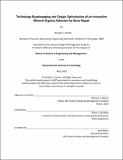| dc.contributor.author | Brown, Michael C.,
S.M.
(Michael Christopher)
Massachusetts Institute of Technology. | en_US |
| dc.contributor.other | Massachusetts Institute of Technology. Engineering and Management Program. | en_US |
| dc.contributor.other | System Design and Management Program. | en_US |
| dc.date.accessioned | 2021-10-08T16:48:11Z | |
| dc.date.available | 2021-10-08T16:48:11Z | |
| dc.date.issued | 2020 | en_US |
| dc.identifier.uri | https://hdl.handle.net/1721.1/132806 | |
| dc.description | Thesis: S.M. in Engineering and Management, Massachusetts Institute of Technology, System Design and Management Program, May, 2020 | en_US |
| dc.description | Cataloged from the official version of thesis. "May 2020." | en_US |
| dc.description | Includes bibliographical references (pages 79-83). | en_US |
| dc.description.abstract | As medical devices become more complex, the need for methodical and structured design processes has never been greater. Due to the great complexity of the aerospace industry, both qualitative and quantitative methods of technology planning and design assessment have been implemented with great success in that industry. These methods, such as technology roadmapping and multi-disciplinary design optimization, show great promise in the medical device field that has traditionally lacked such rigor. This research accomplishes four objectives: Benchmarking of the current development methods used in the medical device industry; Evaluating the current state of the art of adhesive biomaterials; Application of technology roadmapping methods as they relate to the medical device industry, specifically bone adhesives; and, Development of a multidisciplinary design optimization model used for the development of a novel mineral-organic adhesive used in lumbar spine fusion procedures. A Multi-objective optimization found that an optimal design of the mineral-organic adhesive resulted in a slight (1 minute) increase in surgical time, it resulted in a significant reduction of approximately $1,020 in product cost, and more importantly, a reduction in the estimated healing time from 72 to 24 weeks as compared to the baseline design for utilization in the lumbar spine fusion surgical procedure. By accomplishing these four objectives, this thesis outlines the methods and models necessary to bring to market paradigm shifting technologies that will be the catalyst for significant change in the healthcare industry. | en_US |
| dc.description.statementofresponsibility | by Michael C. Brown. | en_US |
| dc.format.extent | 107 pages | en_US |
| dc.language.iso | eng | en_US |
| dc.publisher | Massachusetts Institute of Technology | en_US |
| dc.rights | MIT theses may be protected by copyright. Please reuse MIT thesis content according to the MIT Libraries Permissions Policy, which is available through the URL provided. | en_US |
| dc.rights.uri | http://dspace.mit.edu/handle/1721.1/7582 | en_US |
| dc.subject | Engineering and Management Program. | en_US |
| dc.subject | System Design and Management Program. | en_US |
| dc.title | Technology roadmapping and design optimization of an innovative mineral-organic adhesive for bone repair | en_US |
| dc.type | Thesis | en_US |
| dc.description.degree | S.M. in Engineering and Management | en_US |
| dc.contributor.department | Massachusetts Institute of Technology. Engineering and Management Program | en_US |
| dc.identifier.oclc | 1262987898 | en_US |
| dc.description.collection | S.M.inEngineeringandManagement Massachusetts Institute of Technology, System Design and Management Program | en_US |
| dspace.imported | 2021-10-08T16:48:11Z | en_US |
| mit.thesis.degree | Master | en_US |
| mit.thesis.department | SysDes | en_US |
